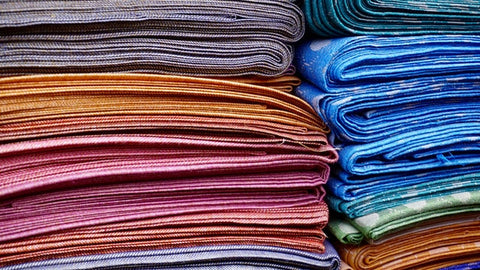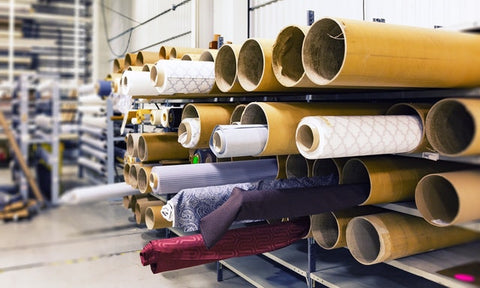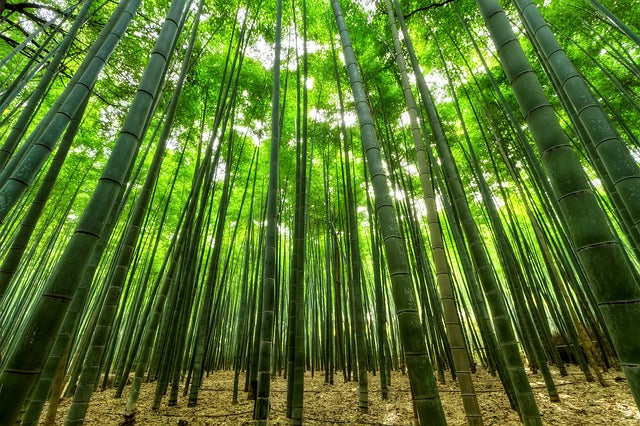Bamboo has quickly become one of the most eco-friendly fabrics in the world. It feels as soft and luxurious as silk and cashmere, but at a fraction of the cost, and has become a favourite material for socks and t-shirts. Bamboo is sustainable, easy to grow, and does very little damage to the environment.
There are two different approaches to extracting the bamboo fibres and making bamboo textile. You can use either the mechanical or chemical process. The mechanical process is less popular as it is more labour intensive and costly.
The mechanical process involves crushing the woody part of the plant, and then using natural enzymes to break the bamboo walls into a mushed up mass, the fibres can then be mechanically combed out and rolled into yarn.
The chemical process involves turning the bamboo fibre into a regenerated cellulose fibre, similar to rayon or modal. This is the most popular and most common process used in the manufacturing of bamboo clothing.

Chemical Process
The chemical process varies from manufacturer to manufacturer, but there are common steps taken when using hydrolysis alkalisation with multi-phase bleaching technology. This is the most used process, and it goes like this.
- The bamboo leaves and the soft, inner pith from the bamboo plant are extracted and crushed.
- The crushed bamboo cellulose is then soaked in a solution of 15% to 20% sodium hydroxide, at a temperature of 20 degrees Celsius and 25 degrees Celsius.
- This soak will then last between 1 and 3 hours and will turn the bamboo cellulose into alkali cellulose.
- The bamboo alkali cellulose is then processed to remove excess sodium hydroxide. The mash that is left over is then crushed by a grinder, before leaving to dry for 24 hours.
- After the drying process, about a third of carbon disulfide is then added to the dry bamboo alkali mash. This causes the compound to sulfurize, and it turns it into a gel type mixture.
- At the end of this step, any remaining carbon disulfide is evaporated and removed due to decompression. The resulting mixture is sodium xanthogenate.
- The next step is to add a diluted solution of sodium hydroxide to the sodium xanthogenate. The sodium hydroxide dissolves the sodium xanthogenate to create a viscose mixture. This mixture consists of 5% sodium hydroxide, and 7%-15% bamboo fibre cellulose.
- The viscose bamboo cellulose is then forced through nozzles into a large container of diluted sulfuric acid solution, which then hardens the viscose bamboo cellulose sodium xanthogenate.
- It is then re-converted into cellulose bamboo fibre threads, which are then spun into bamboo fibre yarns that can be woven into the fabric.

Eco-Friendly Chemical Process
Nowadays though, more eco-friendly methods and chemicals are being used in the chemical process. These processes have substantially reduced the amount of waste and damage to the environment, atmosphere, and the health of workers who handle the material.
The same processes used to produce lyocell from wood cellulose can be adapted and modified to use bamboo cellulose. The lyocell process uses N-methylmorphine-N-oxide to dissolve the bamboo cellulose.
N-methylmorphine-N-oxide is a part of the amine oxide family. Amine oxides are very weak alkalis that act like surfactants and they help break down the cellulose structure into a viscose mixture.
- Hydrogen peroxide is then added as a stabiliser. The solution is passed through spinnerets and into a hardening bath. This hardening bath causes the streams of viscose bamboo solution to harden into bamboo cellulose fibre threads.
- This hardening bath is usually a mixture of water and methanol, or ethanol, or some type of alcohol. The fibres can then be spun into bamboo yarn which can be used for bamboo fabric.
This process is substantially healthier for the environment and for the workers involved in the process. The chemicals used are also captured and recycled, and only trace amounts escape, meaning there is vastly less pollution caused.

Bamboo Fibre Properties
- Naturally soft like silk, however much cheaper
- Bamboo clothing is easier to launder and clean
- The fibres of bamboo clothing are rounded, which makes it less irritating. This is great for people with sensitive skin
- Bamboo fabric is known to be antibacterial and antifungal
- Bamboo fabric and clothing is hypoallergenic and is ideal for anyone with sensitivity towards more common materials.
- Bamboo clothing is highly absorbent and wicks away moisture up to 4 times more efficiently than cotton. In hot and humid climates and conditions, bamboo clothing keeps you cool and won’t stick to your skin.
- The structure and makeup of bamboo fibres make the fabric a lot more breathable and thermal regulating compared to cotton, hemp, wool, or any other synthetic fibres.
- Bamboo clothing is less prone to wrinkles. The clothing may still require an ironing after washing, but you can iron at a lower temperature and shrinkage during washing is minimal.
- Bamboo fabric holds dyes and colours better than cotton and the colour stays brighter for longer, even after many washes.

Is Bamboo Fabric Ethical?
The most important question many people will have after reading this is, is bamboo fabric ethical? The answer can be somewhat tricky, but simply, yes. If it is sourced correctly and processed in the best and most environmentally friendly manner, it can be ethical.
Like most things that gain popularity, there will always be a section of the production sector that wants to produce the material in the quickest time, in the cheapest way, and take make their money as fast as possible.
This is why we said answering if bamboo is ethical can be tricky, cause it completely depends on the growers, the manufacturers, and the clothing makers that then source the material.
Like we mentioned above, these days more and more companies and manufacturers have become aware of the harm fast and mass production of bamboo material can cause and have therefore made huge leaps in improving the process and lessening its effects on the environment.
On the surface, the bamboo fabric may seem like something that damages the ecosystem and environment, but we at Nic Harry are proud of the fact that we use ethically sourced bamboo that is treated in the best possible manner to protect the environment and the people that produce it.


